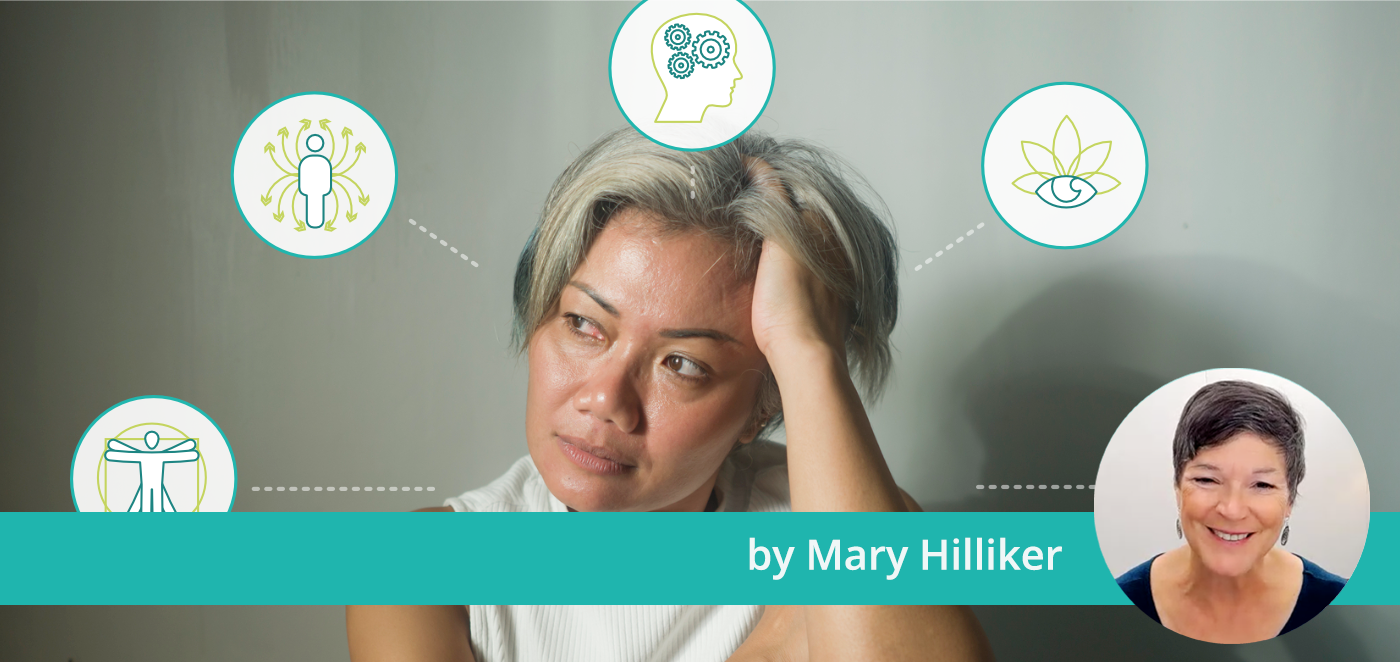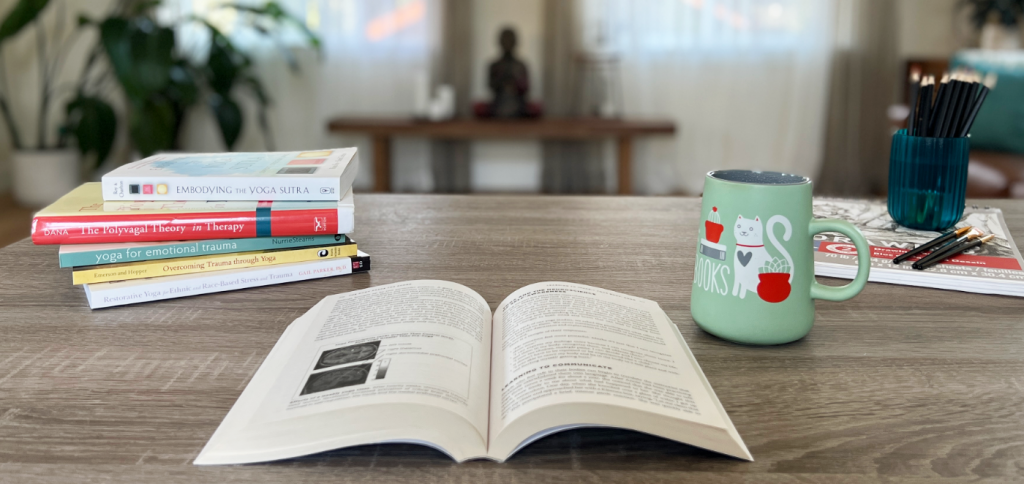
03 Apr Assessment models for working with clients and small therapeutic groups around trauma
Human suffering is universal, but everyone’s experience of suffering is unique, even for those who have been through the same traumatic event. Our role as Yoga Therapists and yoga teachers is to understand as best we can the uniqueness of a client’s experience and to apply the appropriate yoga tools to help them in their journey of recovering and reclaiming their life.
We can turn to our biomedical knowledge for one perspective in our assessment of individuals for Yoga Therapy or small therapeutic groups. Post-traumatic stress disorder is a medical diagnosis, and a client may or may not have sought out medical assessment and intervention. The three main symptoms of post-traumatic stress disorder are flashbacks, upsetting dreams and nightmares, and emotional distress or physical reactions when reminded of the traumatic event.
The Mayo Clinic lists symptoms of post-traumatic stress as:
Behavioral: agitation, irritability, hostility, hypervigilance, self-destructive behavior, or social isolation
Psychological: flashbacks, fear, severe anxiety, mistrust
Mood: loss of interest or pleasure in activities, guilt, or loneliness
Sleep: insomnia or nightmares
Other: emotional detachment or unwanted thoughts
Individuals who live or work in extremely stressful environments may experience traumatic events but also have symptoms of chronic stress, including:
- Body pain
- Low energy
- Poor attention and concentration
- Changes in appetite
- Increased use of substances to treat symptoms
- Change in emotional responses to others
- Emotional withdrawal (Reference: Chronic Stress, Yale Medicine)
The Polyvagal Theory may also provide some perspectives for assessment, as well as client education and intervention tools. The Window of Tolerance is a helpful model for understanding the uniqueness of an individual’s nervous system response to triggers. It can also be a valuable educational tool for creating more awareness around responses.
Understanding the biomedical perspectives is a start in conducting a Yoga Therapy assessment.
Many additional perspectives come from the ancient models that provide a way to see the wholeness of each person you work with. I find several models helpful, including:
- The Pancamaya Model
- Guna-s
- Doshas
- Cakra-s
Let’s take each model and discuss how it might be helpful in working with clients with trauma.
The Pancamaya model is a Vedic model for understanding the dimensions of human experience. Here are some ideas to consider in assessment using this model:
Annamaya (Physical):
Did the client experience any physical injury because of the traumatic event? What is the extent of those injuries, the subsequent treatments, and their current stage of recovery? Does the client have previous injuries or conditions that create physical pain?
Pranamaya (Physiological):
What physiological symptoms are present because of trauma or chronic stress and how often do they appear? Common concerns for people who have experienced trauma are sleep disturbance, lack of daytime energy, digestive distress, heartbeat irregularity, chest pain, disturbed breathing, and headaches.
Manomaya (Mind): How does the person feel they are functioning in terms of managing information, paying attention, and remembering in terms of home and work responsibilities?
Vijnanamaya (Personality, Character): What positive traits are accentuated by their experiences? Which buttons are pushed? How is mood impacting relationships at work and home and in the community? It’s not unusual for clients to express concern about their anger and irritability and how it’s affecting their relationships.
Anandamaya (Heart & Connection to Meaning): What is their perspective on the losses suffered and how to journey through grief? What are their sources of strength and are they connected to those sources? What gives their life meaning and joy and are they connected to those people, activities, or places?
The Guna-s is another model for understanding what’s more dominant in the person’s experience in body and mind.
Rajas: Is their mind terribly busy with a lot of intruding and ruminating thoughts? Are they feeling scattered? Are they physically restless?
Tamas: Do they have a high degree of stability that is helpful? Are they inactive, more isolated and depressed to cope? Do they feel numb and mentally more stagnant as they cope?
Sattva: Are there moments of clarity amid suffering and an ability to enjoy people or experiences that are joyful? As they begin to do some yoga practice, can they find some ease and a reduction in symptoms?
The Ayurvedic dosha-s are a way of understanding symptoms and imbalances but also a way of understanding fundamental strengths for healing and how to approach clients for more optimal therapeutic benefit. Your constitution and your current state as a Yoga Therapist or yoga teacher can impact the therapeutic relationship (more about that in a future blog post).
Vata: Is the client more scattered and restless in mind and body? Are focus and attention a challenge for them? Are they experiencing an ungroundedness that impedes their healing? Do they need a high degree of soothing and nourishing words and practices to help them feel connected? Are they experiencing anger bursts that are quick and explosive but then forgotten?
Pitta: Is the client highly intelligent and ambitious? Do they relate well to understanding their experience and the specific tools that will help them? Is anger a fairly dominant reaction to their experience? Is it smoldering under the surface, ready to come out at any time?
Kapha: Is the client having a tough time motivating themselves to do things that help? Can you find the appropriate ways to motivate and activate them to practice? Is their anger surfacing as a clinging to resentment, grudges, and a lack of finding any kind of forgiveness?
The Cakra Model provides a roadmap of human potential and challenges. As we interact with clients and learn more about their experiences, strengths and challenges often emerge. I find the cakra model helpful in understanding the energetic nature of another’s experience.
1st Cakra – Muladhara: Is their sense of safety and trust disrupted by trauma? How is it that they re-ground themselves when triggered?
2nd Cakra – Svadhisthana: Are they inhibited or stifled by their traumatic experience? Are they able to experience some playfulness in their life, connecting to activities and people they enjoy?
3rd Cakra – Manipura: Is the client able to begin to consider changes that are necessary because of trauma? Are they able to begin to digest some parts of what happened and what it means for the future?
4th Cakra – Anahata: Is the client compassionate toward self, able to openly express their emotions, and seeking connection with others who are helpful in their recovery? What is the depth of their anxiety and anger?
5th Cakra – Visuddhi: Is the client able to express themselves? Are they overly talkative or hesitant in their communication? In small groups, are they able to listen and hear other clients?
6th Cakra – Ajna: Is the client discerning or is there a lack of clarity and indecision at this stage of their recovery?
7th Cakra – Sahasrara: What are sources of strength for the client? Is spirituality or connection to something greater than themselves helpful in their recovery?
Biomedical information and Vedic and Ayurvedic models provide a way to understand a person’s experience as well as form the basis for Yoga Therapy intervention. But before we get to intervention, it’s important to understand a person’s strengths and what’s going well at this stage of their healing. Sometimes medical intervention for PTSD or chronic stress and the beginning of talk therapy or Yoga Therapy is a sign of strength and desire for healing.
Understanding what is currently helping them or even what’s helped them in past challenging times is essential to the intervention process. Getting a complete picture of what triggers them or aggravates symptoms is also important, as what may initially seem like the priority is often temporarily put on hold until aggravators are dealt with. An example might be helping a person with trauma work on better sleep through lifestyle, bedtime rituals and bedtime practice strategies so that they feel more rested and able to engage in practice to help with anxiety.
There are no right or wrong ways to approach assessment. I think of assessment models as something that’s running on low power in the background as I’m having a conversation with a person. Knowing the models well allows me to have a meaningful conversation that brings out essential information. It helps me organize information and understand the following stages of goal-setting and possible intervention tools. I try not to land too hard on conclusions since re-assessment, once tools are introduced, is essential to finding a path forward that works for the client.
The critical thing in assessment is to begin to form a trusting relationship where the client feels seen and heard. I tend to have a sheet in front of me to remind me of things I want to learn more about, but I do not feel tied to a form. I like to be in the conversation, circling back when I need to understand more.
I like to be present in my body, mind, and heart to see, hear and feel their challenges and strengths. As I begin work with a client, I try to take good notes to catch what is working well and what may need to be refined.
 Check out Mary’s Real-Life Case Studies video series on the Sequence Wiz community site. (Available exclusively to Sequence Wiz members. Learn more about Sequence Wiz membership >)
Check out Mary’s Real-Life Case Studies video series on the Sequence Wiz community site. (Available exclusively to Sequence Wiz members. Learn more about Sequence Wiz membership >)
Part 1: Introduction and an overview of the case studies
Part 2: Using micromovements, langhana breathing, and personal mantra to deal with the trauma of a vehicular accident
Part 3: Using breath-centered asana, segmented breathing, and five senses meditation in a therapeutic group
Part 4: Using standing poses, brief breath retention with lengthened exhale, and mantra to regain personal strength
Part 5: Conclusions and lessons learned working with clients and small groups around trauma
Join our Case Studies group to follow along!
More articles on this topic
The role of asana as an intervention tool for collaborating with clients and small therapeutic groups around trauma
A painting is often a complex combination of the totality of it and the independent parts of it that come together to form the work of art. So, too, is our work with clients. Through assessment, we begin to see parts of the whole and then the wholeness of another human being. As we become more educated about another’s experience, we begin the process of co-creating the goals based on the client’s needs and applying the yoga tools that will help them.
The role of the inner practices of yoga for working with clients and small therapeutic groups around trauma
The doorway into yoga for so many westerners is asana. In my last blog, I talked about the role of asana in working with the symptoms of post-traumatic stress. Asana is often a crucial way to carry the breath, impact structure and physiology, and give the mind support.
In the Pancamaya model, asana is a primary tool for impacting the Annamaya layer or physical body.
The healing balm of therapeutic groups and working with the story
Our connection with other human beings is essential to our health and happiness. Traumatic experiences can disrupt that interconnectedness, creating grief and isolation. Often clients are sitting with their story and unable to find ways out of it.
“We humans are storytellers, meaning-making beings, and it is through our autonomic nervous systems that we first create, and then inhabit, our stories. The information that begins in our biology travels autonomic pathways to the brain, and the brain creates a story to make sense of what’s happening in the body.” (Dana, Deborah A. Anchored (p. 150). Sounds True. Kindle Edition.)
Taking care of yourself as a yoga therapist & yoga teacher who works with trauma recovery
The ability to hold the space for clients who have experienced trauma requires the ability to take care of yourself and continue to refine your understanding of suffering and how to come out of suffering. I propose four important ideas:
- Personal Practice
- Studying Yoga Philosophical Teachings on Suffering
- Studying The Evolving Field of Trauma Recovery
- Rituals Of Self-Care.
Virtual event: Working with individuals & small therapeutic groups around trauma (with Mary Hilliker and Olga Kabel)
Working with people who have experienced trauma is some of the most difficult and humbling work that we might take on as yoga therapists or yoga teachers trained in yoga for trauma recovery. Yoga teachings help us understand human suffering from a philosophical perspective. We have yogic frameworks for the assessment and management of a wide range of conditions and symptoms that result from trauma. Putting that knowledge and practical experience of the tools into practice with clients is an ongoing process of professional development and personal growth. Working with people recovering from trauma is humbling and rewarding. It brings us face-to-face with people who are courageous and resilient in the face of suffering.
About Mary
Mary Hilliker is a Registered Dietitian/Nutritionist, an experienced yoga teacher at the E-RYT 500 level and a Certified Yoga Therapist with the International Association of Yoga Therapists (C-IAYT). She studied with Gary Kraftsow of the American Viniyoga Institute for the last 20 years.
 Mary has been mentoring yoga therapists for the last 8 years in their individual client work, development of therapeutic groups and workshops, personal practice and professional transformation. Mary worked with Gary Kraftsow and the American Viniyoga Institute in administrative, faculty and curriculum coordination roles, most recently with the AVI Yoga Therapist Training.
Mary has been mentoring yoga therapists for the last 8 years in their individual client work, development of therapeutic groups and workshops, personal practice and professional transformation. Mary worked with Gary Kraftsow and the American Viniyoga Institute in administrative, faculty and curriculum coordination roles, most recently with the AVI Yoga Therapist Training.
Interest in musculoskeletal health was fundamental to her early start in Yoga Therapy. Her work evolved to a generalist Yoga Therapy practice that also includes a focus on physiological and mental health. Much of her work focuses on beginners and people 55+, people who seek out Yoga Therapy who haven’t been exposed to yoga or Viniyoga. She teaches therapeutic groups and special events such as Yoga for Better Sleep, Yoga for Stressful and Anxious Times, Yoga for Digestive Health, Yoga for Grief & Healing, Yoga Therapy for Structural Conditions, Yoga Therapy for Headaches, Yoga for Seasonal Changes and Yoga for Fatigue.
Mary owns and operates River Flow Yoga Teacher Training School, a Yoga Alliance RYS-200 and RYS-300 in Wausau, Wisconsin. She is a business partner and teacher/yoga therapist with 5 Koshas Yoga & Wellness in Wausau, WI. In that role, she focuses her time on individualized Yoga Therapy, teaching Yoga Therapy groups, webinars and special events, training yoga teachers, and providing continuing education for yoga teachers and yoga therapists.






